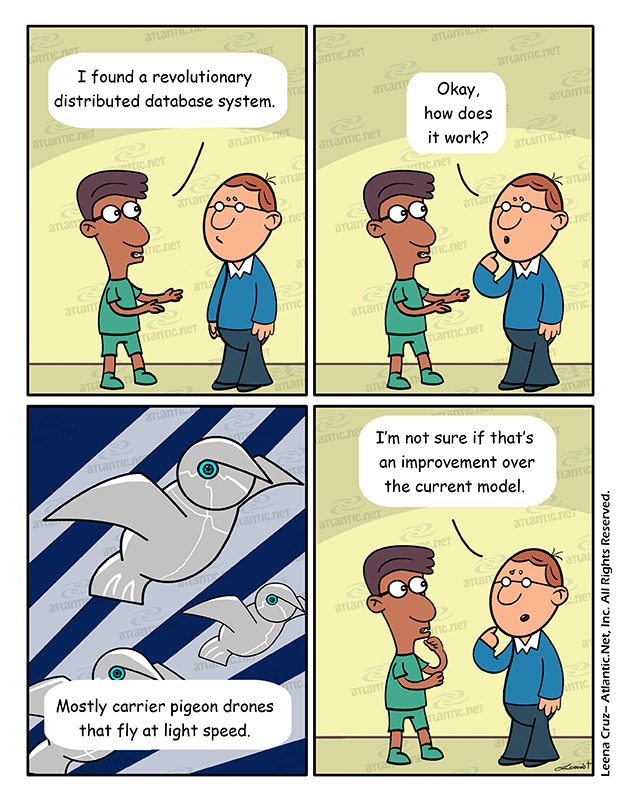What Is a Distributed Database, and What Are Distributed Data Systems For?
May 25, 2014 by Editorial Team ( 450 ) under VPS Hosting
0 Comments
Distributed databases offer some key advantages over centralized databases. Many companies are switching to distributed databases (in which the database, as its name implies, is distributed throughout an array of servers in various locations) for a variety of reasons. Let’s look at some of the basic advantages of distributed databases, a typical scenario in which they are used, and the different formats in which data is distributed throughout the distributed data system.
Why distributed databases are becoming increasingly popular
Here are the basic reasons why many organizations are leaving behind the centralized model in favor of database distribution:
- Reliability – Building infrastructure is similar to investing: diversify to reduce your chances of loss. Specifically, if a failure occurs in one distribution area, the entire database does not experience a setback.
- Security – You can give permissions to single sections of the overall database for better internal and external protection.
- Cost-effective – Bandwidth prices go down because users are accessing remote data less frequently.
- Local access – Similarly to #1 above, if there is a failure in the umbrella network, you can still get access to your portion of the database.
- Growth – If you add a new location to your business, it’s simple to create an additional node within the database, making distribution highly scalable.
- Speed & resource efficiency – Most requests and other interactivity with the database are performed locally, decreasing remote traffic.
- Responsibility & containment – Because any glitches or failures occur locally, the issue is contained. It can potentially be handled by the IT staff designated to handle that piece of the company.
Who uses distributed databases?
Often distributed databases are used by organizations that have numerous offices or storefronts in different geographical locations. Typically an individual branch is interacting primarily with the data that pertain to its own operations, with a much less frequent need for general company data.
There is an inconsistent need for any central information from the branches in that case. However, the company’s home office still must have a steady influx of information from every location.
To solve that issue, a distributed database usually operates by allowing each company location to interact directly with its own database during work hours. During non-peak times, each day, the whole database receives a batch of data from each branch.
Types of distributed data
Replicated data – Replication of data is used to create additional instances of data in different parts of the database. Using this tactic, a distributed database can avoid excessive traffic because identical data can be accessed locally. Distributed data can be divided into five basic types, as outlined below:
This form of data is subdivided into two different types: read-only and writable data. Writable versions can be adjusted, which immediately changes the first instance, with various configurations for how and when all replications throughout the system experience the update. Read-only versions also allow revisions to the first instance, and then the replications are adjusted accordingly.
In this distributed data system, updates can be configured based on how crucial it is that the database has the correct specifics moment by moment (or over whatever time period). Note that replication is especially valuable when you do not need revisions to appear throughout the distributed data system in real-time.
This type of data makes it easy to supply data from any section to any other section of the larger database if the latter section’s data is compromised by any error. Be aware, though, that with replication, collisions can occur. Safeguards must be in place to prevent/resolve them.
Horizontally fragmented data – This category of data distribution involves the use of primary keys (each of which refers to one record in the database). Horizontal fragmentation is commonly used for situations in which specific business locations usually only need access to the database of their specific branch.
Vertically fragmented data – With vertical fragmentation, primary keys are again utilized. However, in this case, copies of the primary key are available within each section of the database (accessible to each branch). This type of format works well for situations where a branch of a business and the central location interact with the same accounts but perhaps in different manners (such as changes to client contact information vs. changes to financial figures).
Reorganized data – Reorganization means that data has been adjusted in one way or another, as is typical for decision-support databases. In some cases, there are two distinct systems handling transactions and decision-support. While decision-support systems can be trickier to maintain technically, online transaction processing (OLTP) often requires reconfiguration to allow for large amounts of requests.
Separate-schema data – This category partitions the database and software used to access it to fit different departments and situations – user data vs. product data, for example. Usually, there is overlap between the various databases within this type of distribution.
For more information on the types of distributed databases and security, check out our blog post on this here. Atlantic.Net is committed to keeping up with the best new advancements in technology through our Resources page that contains How-to Guides, Articles, and FAQs.
***
As you can see, distributed databases represent a huge technological advancement. It’s not surprising that companies are shifting away from centralized databases and embracing the distributed model. Atlantic.Net has many hosting options for various companies, including Windows Private Cloud Hosting, Virtual private servers, managed cloud server hosting, HIPAA compliant hosting, and our award-winning super-fast SSD VPS Hosting servers.
By Moazzam Adnan of cloud server hosting provider Atlantic.Net.
Get a $250 Credit and Access to Our Free Tier!
Free Tier includes:
G3.2GB Cloud VPS a Free to Use for One Year
50 GB of Block Storage Free to Use for One Year
50 GB of Snapshots Free to Use for One Year

